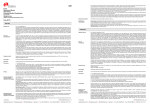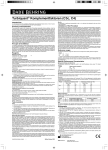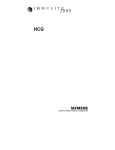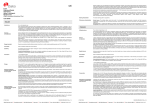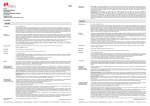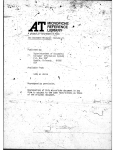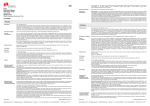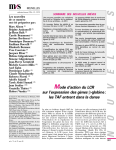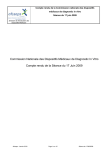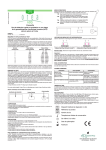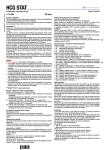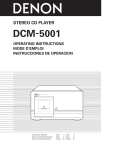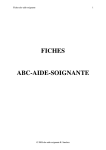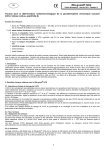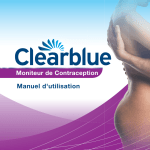Download Dako Autostainer/Autostainer Plus
Transcript
staining pattern is identical to the staining pattern described in “Performance characteristics”. Counterstaining in hematoxylin is recommended using EnVision FLEX Hematoxylin (Dako Autostainer/Autostainer Plus) (Code K8018). Nonaqueous, permanent mounting medium is recommended. FLEX Polyclonal Rabbit Anti-Human Chorionic Gonadotropin Ready-to-Use (Dako Autostainer/Autostainer Plus) Positive and negative controls should be run simultaneously using the same protocol as the patient specimens. The positive control tissue should include placenta and the cells/structures should display reaction patterns as described for this tissue in “Performance characteristics” in all positive specimens. The recommended negative control reagent is FLEX Negative Control, Rabbit (Dako Autostainer/Autostainer Plus) (Code IS600). Code IS508 Staining interpretation The cellular staining pattern is cytoplasmic. Performance characteristics Normal tissues: In first trimester placenta, the antibody labels plentiful syncytiotrophoblast cytoplasmic granules, some undergoing exocytosis (1). Abnormal tissues: 189 orchidectomy specimens with germ cell tumors (95 pure seminomas and 94 non-seminomas) were studied with the antibody. hCG was demonstrated in all choriocarcinoma components in the syncytiotrophoblasts and syncytiotrophoblast-like cells in 8% of seminomas and 30% of non-seminomas. Carcinoma-in-situ present in seminiferous tubules adjecent to the tumors was positive for hCG in a few cases (2). ENGLISH Intended use For in vitro diagnostic use. FLEX Polyclonal Rabbit Anti-Human Chorionic Gonadotropin, Ready-to-Use, (Dako Autostainer/Autostainer Plus), is intended for use in immunohistochemistry together with Dako Autostainer/Autostainer Plus instruments. This antibody is useful for the identification of hCGcontaining cells (1) and may be used for the demonstration of trophoblastic elements, e.g. in germ cell tumors (2). The clinical interpretation of any staining or its absence should be complemented by morphological studies using proper controls and should be evaluated within the context of the patient's clinical history and other diagnostic tests by a qualified pathologist. Human chorionic gonadotropin (hCG) is a 40 kDa glycoprotein composed of two subunits, α and β. The α subunit is common for hCG, luteinizing hormone (LH), follicle stimulating hormone (FSH), and thyroid stimulating hormone (TSH), while the β subunit is unique for hCG although its amino acid sequence partially is identical with that of the β subunit of LH (3, 4). hCG is the most important marker of gestational trophoblastic cells, being present in syncytiotrophoblastic cells and cells of the intermediate trophoblast but absent in cytotrophoblasts. hCG expression has also been demonstrated in some non-trophoblastic tumors, e.g. in 14% of patients with hepatocellular carcinoma (4). In pregnancy, the serum hCG concentration increases at an exponential rate initially, then peaks at around 100 kIU/L at about the tenth week after conception. The concentration decreases about tenfold over the next several weeks followed by a small increase near term (5). Summary and explanation FRANÇAIS Utilisation prévue Résumé et explication Refer to Dako’s General Instructions for Immunohistochemical Staining or the detection system instructions of IHC procedures for: 1) Principle of Procedure, 2) Materials Required, Not Supplied, 3) Storage, 4) Specimen Preparation, 5) Staining Procedure, 6) Quality Control, 7) Troubleshooting, 8) Interpretation of Staining, 9) General Limitations. Reagent provided Ready-to-use polyclonal rabbit antibody provided in liquid form in a buffer containing stabilizing protein and 0.015 mol/L NaN3. Immunogen The isolated beta-chain of hCG. Specificity The antibody reacts with hCG, and like most other polyclonal antibodies to beta-hCG it also shows a slight cross-reaction (about 4%) with LH (3). Traces of contaminating antibodies to human plasma proteins have been removed by solid-phase absorption. In crossed immunoelectrophoresis only the hCG precipitation arch appears when using 12.5 µL Dako Code A0231 per cm2 gel area against 10 µL of concentrated urine from pregnant women (15th-16th week of gestation). No precipitation is seen when 12.5 µL concentrated antibody per cm2 gel area is tested against 10 µL of normal human plasma. Staining: Coomassie Brilliant Blue. Pour utilisation diagnostique in vitro. FLEX Polyclonal Rabbit Anti-Human Chorionic Gonadotropin, Ready-to-Use, (Dako Autostainer/Autostainer Plus) est destiné à une utilisation en immunohistochimie avec les instruments Dako Autostainer/Autostainer Plus. Cet anticorps est utile pour l’identification des cellules contenant de la hCG (1) et peut être utilisé pour détecter des éléments trophoblastiques, comme dans des tumeurs à cellules germinales (2). L’interprétation clinique de toute coloration ou son absence doit être complétée par des études morphologiques en utilisant des contrôles appropriés et doit être évaluée en fonction des antécédents cliniques du patient et d’autres tests diagnostiques par un pathologiste qualifié. L’hormone gonadotrophine chorionique humaine (hCG) est une glycoprotéine de 40 kDa composée de deux sous-unités, α et β. La sousunité α est couramment associée à la hCG, à l’hormone lutéinisante (LH), à l’hormone folliculostimulante (FSH) et à l’hormone thyréostimulante (TSH), alors que la sous-unité β n’est exprimée qu’en présence de hCG, bien que sa séquence d’acides aminés soit partiellement identique à celle de la sous-unité β de la LH (3, 4). La hCG est le plus important marqueur de cellules trophoblastiques gestationnelles, étant présente dans les cellules syncytiotrophoblastiques et les cellules des trophoblastes intermédiaires mais absente des cytotrophoblastes. L’expression de la hCG a également été mise en évidence dans certaines tumeurs non trophoblastiques, par exemple chez 14 % des patients souffrant d’un carcinome hépatocellulaire (4). Pendant la grossesse, la concentration en hCG sérique augmente à une vitesse exponentielle d’abord, puis se stabilise autour de 100 000 UI/L à la dixième semaine après la conception environ. La concentration est divisée par dix environ pendant les quelques semaines qui suivent, puis augmente légèrement à l’approche du terme (5). Se référer aux Instructions générales de coloration immunohistochimique de Dako ou aux instructions du système de détection relatives aux procédures IHC pour plus d’informations concernant les points suivants : 1) Principe de procédure, 2) Matériels requis mais non fournis, 3) Conservation, 4) Préparation des échantillons, 5) Procédure de coloration, 6) Contrôle qualité, 7) Dépannage, 8) Interprétation de la coloration, 9) Limites générales. Réactifs fournis Anticorps polyclonal de lapin prêt à l’emploi fourni sous forme liquide dans un tampon contenant une protéine stabilisante et 0,015 mol/L d’azide de sodium. 1. For professional users. 2. This product contains sodium azide (NaN3), a chemical highly toxic in pure form. At product concentrations, though not classified as hazardous, sodium azide may react with lead and copper plumbing to form highly explosive build-ups of metal azides. Upon disposal, flush with large volumes of water to prevent metal azide build-up in plumbing. 3. As with any product derived from biological sources, proper handling procedures should be used. 4. Wear appropriate Personal Protective Equipment to avoid contact with eyes and skin. 5. Unused solution should be disposed of according to local, State and Federal regulations. Immunogène Chaîne bêta isolée de la hCG. Spécificité L'anticorps réagit à la hCG et, comme la plupart des autres anticorps polyclonaux dirigés contre la bêta-hCG, il présente aussi une réaction croisée à la LH (environ 4 %) (3). Les traces d’anticorps contaminant les protéines de plasma humain ont été éliminées par absorption à l’état solide. Storage Store at 2-8 °C. Do not use after expiration date sta mped on vial. If reagents are stored under any conditions other than those specified, the conditions must be verified by the user. There are no obvious signs to indicate instability of this product. Therefore, positive and negative controls should be run simultaneously with patient specimens. If unexpected staining is observed which cannot be explained by variations in laboratory procedures and a problem with the antibody is suspected, contact Dako Technical Support. Précautions Specimen preparation including materials required but not supplied The antibody can be used for labeling formalin-fixed, paraffin-embedded tissue sections. Tissue specimens should be cut into sections of approximately 4 µm. 1. Pour utilisateurs professionnels. 2. Ce produit contient de l’azide de sodium (NaN3), produit chimique hautement toxique dans sa forme pure. Aux concentrations du produit, bien que non classé comme dangereux, l’azide de sodium peut réagir avec le cuivre et le plomb des canalisations et former des accumulations d’azides métalliques hautement explosifs. Lors de l’élimination, rincer abondamment à l’eau pour éviter toute accumulation d’azide métallique dans les canalisations. 3. Comme avec tout produit d’origine biologique, des procédures de manipulation appropriées doivent être respectées. 4. Porter un vêtement de protection approprié pour éviter le contact avec les yeux et la peau. 5. Les solutions non utilisées doivent être éliminées conformément aux réglementations locales et nationales. Conservation Conserver entre 2 et 8 °C. Ne pas utiliser après la date de péremption indiquée sur le flacon. Si les réactifs sont conservés dans des conditions autres que celles indiquées, celles-ci doivent être validées par l’utilisateur. Il n’y a aucun signe évident indiquant l’instabilité de ce produit. Par conséquent, des contrôles positifs et négatifs doivent être testés en même temps que les échantillons de patient. Si une coloration inattendue est observée, qui ne peut être expliquée par un changement des procédures du laboratoire, et en cas de suspicion d’un problème lié à l’anticorps, contacter l’assistance technique de Dako. Préparation des échantillons y compris le matériel requis mais non fourni L’anticorps peut être utilisé pour le marquage des coupes de tissus inclus en paraffine et fixés au formol. L’épaisseur des coupes d’échantillons de tissu doit être d’environ 4 µm. Precautions Pre-treatment with heat-induced epitope retrieval (HIER) is required using Dako PT Link (Code PT100/PT101). For details, please refer to the PT Link User Guide. Optimal results are obtained by pretreating tissues using EnVision FLEX Target Retrieval Solution, High pH (50x) (Code K8010/K8004). Paraffin-embedded sections: Pre-treatment of formalin-fixed, paraffin-embedded tissue sections is recommended using the 3-in-1 specimen preparation procedure for Dako PT Link. Follow the pre-treatment procedure outlined in the package insert for EnVision FLEX Target Retrieval Solution, High pH (50x) (Code K8010/K8004). Note: After staining the sections must be dehydrated, cleared and mounted using permanent mounting medium. Deparaffinized sections: Pre-treatment of deparaffinized formalin-fixed, paraffin-embedded tissue sections is recommended using Dako PT Link and following the same procedure as described for paraffin-embedded sections. After staining the slides should be mounted using aqueous or permanent mounting medium. The tissue sections should not dry out during the treatment or during the following immunohistochemical staining procedure. For greater adherence of tissue sections to glass slides, the use of FLEX IHC Microscope Slides (Code K8020) is recommended. Staining procedure including materials required but not supplied Lors d’une immunoélectrophorèse croisée, l'arc de précipitation de la hCG apparaît seulement lorsqu’on utilise 12,5 µL (Réf. Dako A0231) par cm² de gel pour 10 µL d'urine concentrée de femme enceinte (15e ou 16e semaine de gestation). Aucun arc de précipitation n'apparaît lorsqu’on utilise 12,5 µL d’anticorps concentré par cm² de gel pour 10 µL de plasma humain normal. Coloration : Bleu de Coomassie. The recommended visualization system is EnVision FLEX, High pH (Dako Autostainer/Autostainer Plus) (Code K8010). The staining steps and incubation times are pre-programmed into the software of Dako Autostainer/Autostainer Plus instruments, using the following protocols: Coupes incluses en paraffine : le prétraitement des coupes tissulaires fixées au formol et incluses en paraffine est recommandé à l'aide de la procédure de préparation d'échantillon 3-en-un pour le Dako PT Link. Suivre la procédure de prétraitement indiquée dans la notice de la EnVision FLEX Target Retrieval Solution, High pH (50x) (Réf. K8010/K8004). Remarque : après coloration, les coupes doivent être déshydratées, lavées et montées à l’aide d’un milieu de montage permanent. Template protocol: FLEXRTU2 (200 µL dispense volume) or FLEXRTU3 (300 µL dispense volume) Autoprogram: hCG (without counterstaining) or hCGH (with counterstaining) The Auxiliary step should be set to “rinse buffer” in staining runs with ≤10 slides. For staining runs with >10 slides the Auxiliary step should be set to “none”. This ascertains comparable wash times. Coupes déparaffinées : le prétraitement des coupes tissulaires déparaffinées, fixées au formol et incluses en paraffine, est recommandé à l’aide du Dako PT Link, en suivant la même procédure que pour les coupes incluses en paraffine. Après coloration, un montage aqueux ou permanent des lames est recommandé. All incubation steps should be performed at room temperature. For details, please refer to the Operator’s Manual for the dedicated instrument. If the protocols are not available on the used Dako Autostainer platform, please contact Dako Technical Services. Les coupes de tissus ne doivent pas sécher lors du traitement ni lors de la procédure de coloration immunohistochimique suivante. Pour une meilleure adhérence des coupes de tissus sur les lames de verre, il est recommandé d’utiliser des lames FLEX IHC Microscope Slides (Réf. K8020). Optimal conditions may vary depending on specimen and preparation methods, and should be determined by each individual laboratory. If the evaluating pathologist should desire a different staining intensity, a Dako Application Specialist/Technical Service Specialist can be contacted for information on re-programming of the protocol. Verify that the performance of the adjusted protocol is still valid by evaluating that the (115264-002) Dako Denmark A/S IS508/EFG/MNI/2009.12.04 p. 1/4 | Produktionsvej 42 | DK-2600 Glostrup | Denmark | Tel. +45 44 85 95 00 | Fax +45 44 85 95 95 | CVR No. 33 21 13 17 Un prétraitement avec démasquage d’épitope induit par la chaleur (HIER) est nécessaire avec le Dako PT Link (Réf. PT100/PT101). Pour plus de détails, se référer au Guide d’utilisation du PT Link. Des résultats optimaux sont obtenus en prétraitant les tissus à l’aide de la EnVision FLEX Target Retrieval Solution, High pH (50x) (Réf. K8010/K8004). (115264-002) Dako Denmark A/S IS508/EFG/MNI/2009.12.04 p. 2/4 | Produktionsvej 42 | DK-2600 Glostrup | Denmark | Tel. +45 44 85 95 00 | Fax +45 44 85 95 95 | CVR No. 33 21 13 17 Procédure de coloration y compris le matériel requis mais non fourni Le système de visualisation recommandé est le EnVision FLEX, High pH, (Dako Autostainer/Autostainer Plus) (Réf. K8010). Les étapes de coloration et d’incubation sont préprogrammées dans le logiciel des instruments Dako Autostainer/Autostainer Plus, à l’aide des protocoles suivants : Protocole modèle : FLEXRTU2 (volume de distribution de 200 µL) Autoprogram : hCG (sans contre-coloration) ou hCGH (avec contre-coloration) ou FLEXRTU3 (volume de distribution de 300 µL) Vorbereitung der Probe und erforderliche, aber nicht mitgelieferte Materialien L’étape Auxiliary doit être réglée sur « rinse buffer » lors des cycles de coloration avec ≤10 lames. Pour les cycles de coloration de >10 lames, l’étape Auxiliary doit être réglée sur « none ». Cela garantit des temps de lavage comparables. Entparaffinierte Schnitte: Eine Vorbehandlung der entparaffinierten, formalinfixierten, paraffineingebetteten Gewebeschnitte mit Dako PT Link nach demselben Verfahren, wie für die paraffineingebetteten Schnitte beschrieben, wird empfohlen. Die Objektträger nach dem Färben mit einem wässrigen oder permanenten Einbettmedium bedecken. Les conditions optimales peuvent varier en fonction du prélèvement et des méthodes de préparation, et doivent être déterminées par chaque laboratoire individuellement. Si le pathologiste qui réalise l’évaluation désire une intensité de coloration différente, un spécialiste d’application/spécialiste du service technique de Dako peut être contacté pour obtenir des informations sur la re-programmation du protocole. Vérifier que l'exécution du protocole modifié est toujours valide en vérifiant que le schéma de coloration est identique au schéma de coloration décrit dans les « Caractéristiques de performance ». Des contrôles positifs et négatifs doivent être réalisés en même temps et avec le même protocole que les échantillons du patient. Le contrôle de tissu positif doit comprendre le placenta et les cellules/structures doivent présenter des schémas de réaction tels que décrits pour ces tissus dans les « Caractéristiques de performance » pour tous les échantillons positifs. Le contrôle négatif recommandé est le FLEX Negative Control, Rabbit (Dako Autostainer/Autostainer Plus) (Réf. IS600). Die Gewebeschnitte dürfen während der Behandlung oder des anschließenden immunhistochemischen Färbeverfahrens nicht austrocknen. Zur besseren Haftung der Gewebeschnitte an den Glasobjektträgern wird die Verwendung von FLEX IHC Microscope Slides (Code-Nr. K8020) empfohlen. Färbeverfahren und erforderliche, aber nicht mitgelieferte Materialien Das empfohlene Visualisierungssystem ist EnVision™ FLEX, High pH (Dako Autostainer/Autostainer Plus) (Code-Nr. K8010). Die Färbeschritte und Inkubationszeiten sind in der Software der Dako Autostainer/Autostainer Plus-Geräte mit den folgenden Protokollen vorprogrammiert: Matrix-Protokoll: FLEXRTU2 (200 µL Abgabevolumen) oder FLEXRTU3 (300 µL Abgabevolumen) Autoprogram: hCG (ohne Gegenfärbung) oder hCGH (mit Gegenfärbung) Bei Färbedurchläufen mit höchstens 10 Objektträgern sollte der „Zusatz“-Schritt auf „Pufferspülgang“ eingestellt werden. Für Färbedurchläufe mit mehr als 10 Objektträgern den „Zusatz“-Schritt auf „Keine“ einstellen. Dieses gewährleistet vergleichbare Waschzeiten. Interprétation de la coloration Le schéma de coloration cellulaire est cytoplasmique. Caractéristiques de performance Tissus sains : Dans les échantillons de placenta prélevés au premier trimestre, l’anticorps marque de très nombreux granules cytoplasmiques du syncytiotrophoblaste, dont certains subissent une exocytose (1). Alle Inkubationsschritte sollten bei Raumtemperatur durchgeführt werden. Nähere Einzelheiten bitte dem Benutzerhandbuch für das jeweilige Gerät entnehmen. Wenn die Färbeprotokolle auf dem verwendeten Dako Autostainer-Gerät nicht verfügbar sind, bitte den Technischen Kundendienst von Dako verständigen. Optimale Bedingungen können je nach Probe und Präparationsverfahren unterschiedlich sein und sollten vom jeweiligen Labor selbst ermittelt werden. Falls der beurteilende Pathologe eine andere Färbungsintensität wünscht, kann ein Anwendungsspezialist oder Kundendiensttechniker von Dako bei der Neuprogrammierung des Protokolls helfen. Die Leistung des angepassten Protokolls muss verifiziert werden, indem gewährleistet wird, dass das Färbemuster mit dem unter „Leistungsmerkmale“ beschriebenen Färbemuster identisch ist. Tissus tumoraux : 189 échantillons d’orchidectomie contenant des tumeurs à cellules germinales (95 séminomes purs et 94 non-séminomes) ont été étudiés en utilisant l’anticorps. La présence de hCG a été mise en évidence dans tous les composants du choriocarcinome dans les syncytiotrophoblastes et les cellules assimilées aux syncytiotrophoblastes dans 8 % des séminomes et 30 % des non-séminomes. Un carcinome in situ présent dans les tubules séminifères adjacents aux tumeurs était positif à la hCG dans quelques cas (2). Die Gegenfärbung in Hämatoxylin sollte mit EnVision™ FLEX Hematoxylin (Code-Nr. K8018) ausgeführt werden. Empfohlen wird ein nichtwässriges, permanentes Fixiermittel. Positiv- und Negativkontrollen sollten zur gleichen Zeit und mit demselben Protokoll wie die Patientenproben getestet werden. Das positive Kontrollgewebe sollte Plazentagewebe enthalten und die Zellen/Strukturen müssen in allen positiven Proben die für dieses Gewebe unter „Leistungsmerkmale“ beschriebenen Reaktionsmuster aufweisen. Das empfohlene negative Kontrollreagenz ist FLEX Negative Control, Rabbit (Dako Autostainer/Autostainer Plus) (Code-Nr. IS600). DEUTSCH Zweckbestimmung Zur In-vitro-Diagnostik. FLEX Polyclonal Rabbit Anti-Human Chorionic Gonadotropin, Ready-to-Use, (Dako Autostainer/Autostainer Plus) ist zur Verwendung in der Immunhistochemie in Verbindung mit Dako Autostainer/Autostainer Plus-Geräten bestimmt. Dieser Antikörper dient zur Erkennung von hCGenthaltenden Zellen (1) und kann zur Demonstration von trophoblastischen Elementen, z. B. in Keimzelltumoren, verwendet werden (2). Die klinische Auswertung einer eventuell eintretenden Färbung sollte durch morphologische Studien mit ordnungsgemäßen Kontrollen ergänzt werden und von einem qualifizierten Pathologen unter Berücksichtigung der Krankengeschichte und anderer Diagnostiktests des Patienten vorgenommen werden. Zusammenfassung und Erklärung Die Vorbehandlung durch hitzeinduzierte Epitopdemaskierung (HIER) mit Dako PT Link (Code-Nr. PT100/PT101) ist erforderlich. Weitere Informationen hierzu siehe PT Link-Benutzerhandbuch. Optimale Ergebnisse können durch Vorbehandlung der Gewebe mit EnVision FLEX Target Retrieval Solution, High pH (50x) (Code-Nr. K8010/K8004) erzielt werden. Paraffineingebettete Schnitte: Die Vorbehandlung der formalinfixierten, paraffineingebetteten Schnitte mit dem 3-in-1Probenvorbereitungsverfahren für Dako PT Link wird empfohlen. Vorbehandlung gemäß der Beschreibung in der Packungsbeilage für EnVision FLEX Target Retrieval Solution, High pH (50x) (Code-Nr. K8010/K8004) durchführen. Hinweis: Nach dem Färben müssen die Schnitte dehydriert, geklärt und mit permanentem Einbettmedium auf den Objektträger aufgebracht werden. Toutes les étapes d’incubation doivent être effectuées à température ambiante. Pour plus de détails, se référer au Manuel de l’opérateur spécifique à l'instrument. Si les protocoles ne sont pas disponibles sur la plateforme Dako Autostainer utilisée, contacter le service technique de Dako. Il est recommandé d’effectuer une contre-coloration à l’aide de EnVision™ FLEX Hematoxylin (Dako Autostainer/Autostainer Plus) (Réf. K8018). L’utilisation d’un milieu de montage permanent non aqueux est recommandée. Der Antikörper eignet sich zur Markierung von formalinfixierten und paraffineingebetteten Gewebeschnitten. Gewebeproben sollten in Schnitte von ca. 4 µm Stärke geschnitten werden. Menschliches chorionisches Gonadotropin (hCG) ist ein 40-kDa-Glykoprotein, das aus zwei Untereinheiten, α und β, besteht. Die αUntereinheit kommt bei hCG, dem Luteinisierungshormon (LH), dem follikelstimulierenden Hormon (FSH) und dem thyroideastimulierenden Hormon (TSH) vor, während die β-Untereinheit für hCG einzigartig ist, obwohl seine Aminosäurensequenz teilweise mit derjenigen der βUntereinheit von LH identisch ist (3, 4). hCG ist der wichtigste Marker der trophoblastischen Schwangerschaftszellen und findet sich in synzytiotrophoblastischen Zellen und Zellen der intermediären Trophoblasten, ist jedoch nicht in Zytotrophoblasten vorhanden. Die hCGExpression wurde ebenfalls in einigen nicht-trophoblastischen Tumoren nachgewiesen, z. B. bei 14 % der Patienten mit hepatozellulärem Karzinom. Während der Schwangerschaft steigt die hCG-Konzentration des Serums anfänglich mit einer exponentiellen Rate an und erreicht ihren Spitzenwert bei ca. 100 kIU/L ungefähr zehn Wochen nach der Empfängnis. Während der darauf folgenden Wochen sinkt die Konzentration nahezu auf ein Zehntel ab, woraufhin zum Geburtszeitpunkt hin eine kleine Erhöhung folgt (5). Folgende Angaben bitte den Allgemeinen Richtlinien zur immunhistochemischen Färbung von Dako oder den Anweisungen des Detektionssystems für IHC-Verfahren entnehmen: 1) Verfahrensprinzip, 2) Erforderliche, aber nicht mitgelieferte Materialien, 3) Aufbewahrung, 4) Vorbereitung der Probe, 5) Färbeverfahren, 6) Qualitätskontrolle, 7) Fehlersuche und -behebung, 8) Auswertung der Färbung, 9) Allgemeine Beschränkungen. Auswertung der Färbung Das zelluläre Färbemuster ist zytoplasmatisch. Leistungsmerkmale Gesundes Gewebe: In der Plazenta markiert der Antikörper im ersten Trimester zahlreiche zytoplasmatische Granula der Synzytiotrophoblasten, wobei bei einigen eine Exozytose auftritt (1). Pathologisches Gewebe: Mit dem Antikörper untersucht wurden 189 Orchidektomieproben mit Keimzelltumoren (95 reine Seminome und 94 nicht-seminomatöse Hodentumore). In den Synzytiotrophoblasten und synzytiotrophoblastenartigen Zellen aller Choriokarzinom-Komponenten wurde hCG bei 8 % der Seminome und bei 30 % der Nichtseminom-Hodentumore nachgewiesen. In-situ-Karzinom in den Hodenkanälchen in der Nähe der Tumore war in einigen Fällen hCG-positiv (2). References/ Références/ Literatur 1. Morrish DW, Marusyk H, Siy O. Demonstration of specific secretory granules for human chorionic gonadotropin in placenta. J Histochem Cytochem 1987;35:93-101. 2. Jacobsen GK, Jacobsen M. Alpha-fetoprotein (AFP) and human chorionic gonadotropin (HCG) in testicular germ cell tumors. A prospective immunohistochemical study. Acta Path Microbiol Immunol Scand Sect A 1983;91:165-76. 3. Mehta HC, MacDonald DJ. A sensitive enzyme immunoassay specific for human chorionic gonadotrophin. Clin Chim Acta 1982;121:245-50. 4. Leong AS-Y, Cooper K, Leong FJW-M. Manual of diagnostic antibodies for immunohistology; London: Oxford University Press; 1999. p. 25-6. 5. The National Committee for Clinical Laboratory Standards (NCCLS). Choriogonadotropin testing: Nomenclature, reference preparations, assay performance, and clinical application; Approved guideline. NCCLS document I/LA10-A (1-56238-314-0) NCCLS, 940 West Valley Road, Suite 1400, Wayne, Pennsylvania 19087-1898 USA; 1996. Geliefertes Reagenz Gebrauchsfertiger polyklonaler Kaninchen-Antikörper in flüssiger Form in einem Puffer, der stabilisierendes Protein und 0,015 mol/L NaN3 enthält. Immunogen Die isolierte Beta-Kette von hCG. Spezifität Der Antikörper reagiert mit hCG und weist, ähnlich wie die meisten anderen polyklonalen Antikörper gegenBeta-hCG, auch eine leichte Kreuzreaktion mit LH auf (ca. 4 %) (3). Spuren von Antikörpern gegen andere menschliche Plasmaproteine wurden durch Festphasen-Absorption entfernt. Catalogue number Référence catalogue Bestellnummer Temperature limitation Limites de température Use by Utiliser avant Zulässiger Temperaturbereich Verwendbar bis Werden in einer gekreuzten Immunelektrophorese 12,5 µL Dako Code-Nr. A0231 pro cm2 Gelfläche gegen 10 µL konzentrierten Urins von schwangeren Frauen verwendet (15. bis 16. Schwangerschaftswoche), so erscheint nur der hCG-Präzipitationsbogen. Keine Präzipitation wird 2 beobachtet, wenn 12,5 µL Antikörperkonzentrat pro cm Gelfläche gegen 10 µL normales menschliches Plasma getestet wird. Färbung: Coomassie Brilliant Blue. In vitro diagnostic medical device Dispositif médical de diagnostic in vitro In-vitro-Diagnostikum Contains sufficient for <n> tests Contenu suffisant pour <n> tests Manufacturer Fabricant Inhalt ausreichend für <n> Tests Hersteller Consult instructions for use Voir les instructions d’utilisation Gebrauchsanweisung beachten Batch code Numéro de lot Vorsichtsmaßnahmen Explanation of symbols/ Explication des symboles/ Erläuterung der Symbole 1. Nur für Fachpersonal bestimmt. 2. Dieses Produkt enthält Natriumazid (NaN3), eine in reiner Form äußerst giftige Chemikalie. Natriumazid kann auch in als ungefährlich eingestuften Konzentrationen mit Blei- und Kupferrohren reagieren und hochexplosive Metallazide bilden. Nach der Entsorgung stets mit viel Wasser nachspülen, um Metallazidansammlungen in den Leitungen vorzubeugen. Chargenbezeichnung 3. Wie alle Produkte biologischen Ursprungs müssen auch diese entsprechend gehandhabt werden. 4. Geeignete Schutzkleidung tragen, um Augen- und Hautkontakt zu vermeiden. 5. Nicht verwendete Lösung ist entsprechend örtlichen, bundesstaatlichen und staatlichen Richtlinien zu entsorgen Lagerung (115264-002) Dako Denmark A/S Bei 2–8 °C aufbewahren. Nach Ablauf des auf dem Fläsch chen aufgedruckten Verfalldatums nicht mehr verwenden. Werden die Reagenzien unter anderen als den angegebenen Bedingungen aufbewahrt, müssen diese Bedingungen vom Benutzer validiert werden. Es gibt keine offensichtlichen Anzeichen für eine eventuelle Produktinstabilität. Positiv- und Negativkontrollen sollten daher zur gleichen Zeit wie die Patientenproben getestet werden. Falls es zu einer unerwarteten Färbung kommt, die sich nicht durch Unterschiede bei Laborverfahren erklären lässt und auf ein Problem mit dem Antikörper hindeutet, ist der technische Kundendienst von Dako zu verständigen. IS508/EFG/MNI/2009.12.04 p. 3/4 | Produktionsvej 42 | DK-2600 Glostrup | Denmark | Tel. +45 44 85 95 00 | Fax +45 44 85 95 95 | CVR No. 33 21 13 17 (115264-002) Dako Denmark A/S IS508/EFG/MNI/2009.12.04 p. 4/4 | Produktionsvej 42 | DK-2600 Glostrup | Denmark | Tel. +45 44 85 95 00 | Fax +45 44 85 95 95 | CVR No. 33 21 13 17


